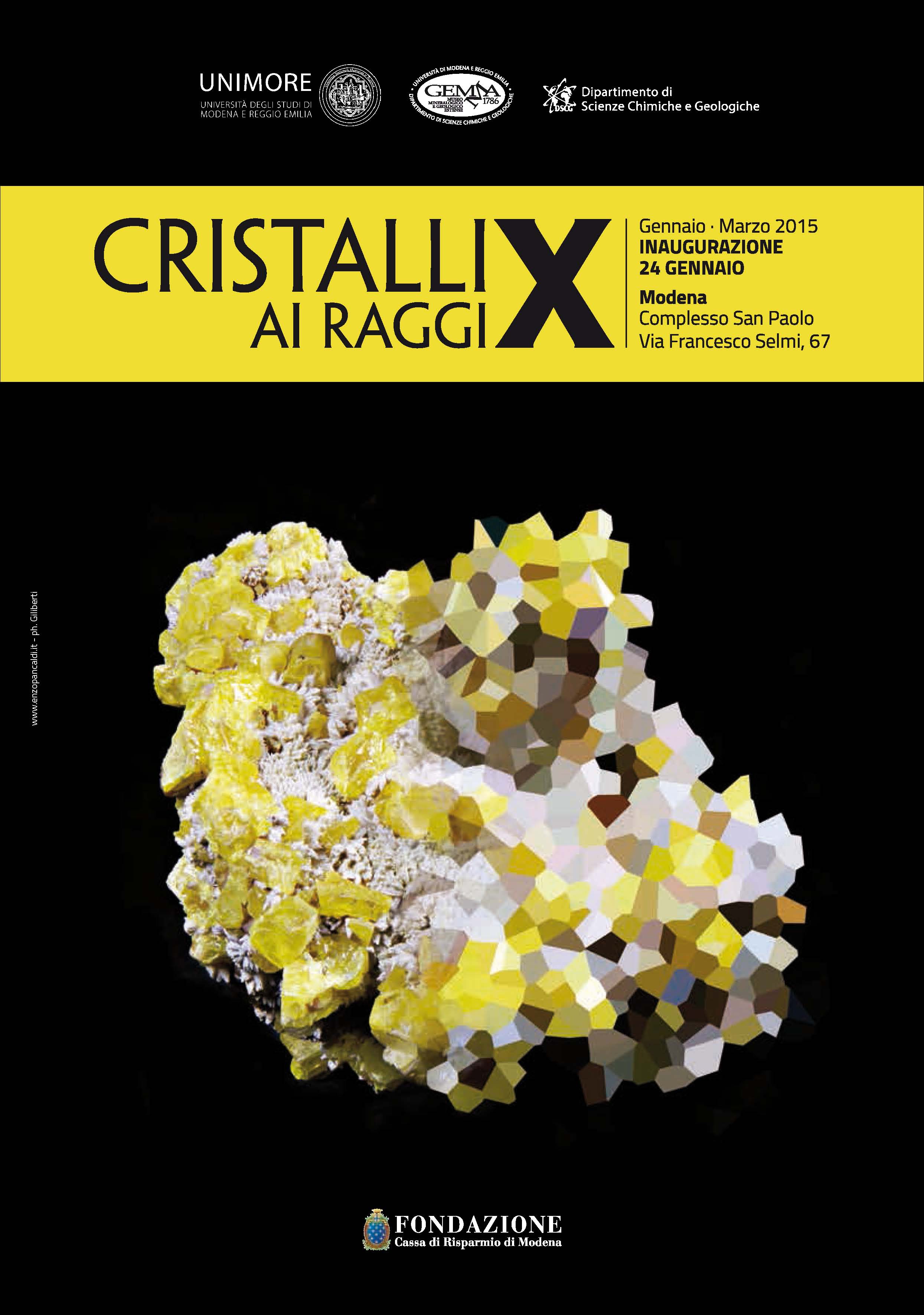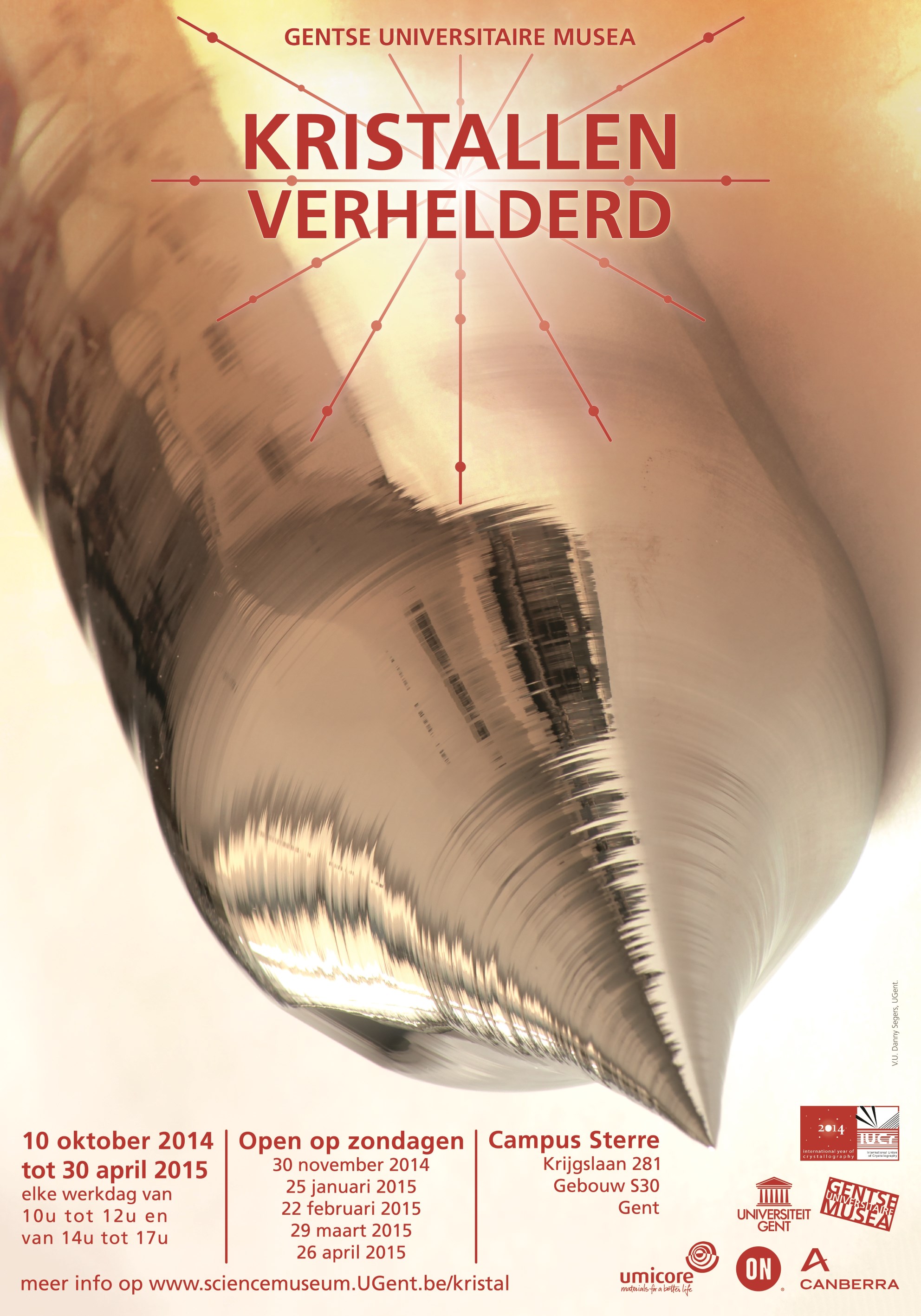4th February 2015
<< Previous Day Week view Next Day >>

| Event Name | Cristalli ai raggi X |
| Start Date | 24th Jan 2015 11:00am |
| End Date | 30th Mar 2015 7:00pm |
| Duration | 65 days and 7 hours |
| Description | Cristalli “ai raggi X”: An exhibition to present the world of crystals
24 January - 30 March 2015 Modena, S. Paolo cloister, via F. Selmi On July 2012, resolution 66/284 of the General Assembly of the United Nations declared 2014 the International Year of Crystallography- 100 years after the awarding of the first Nobel Prize for the discovery of the diffraction of X-rays by crystals. On this occasion, the Department of Chemical and Geological Sciences of the University of Modena and Reggio Emilia is organizing an exhibition entitled Cristalli “ai raggi X”. The purpose of this event is to introduce non specialists to crystals and their properties, and to show how crystallography plays a role in the development of scientific disciplines like chemistry, physics, Earth science, biology and medicine. The exhibition highlights in a simple and understandable way the links between crystals, science, technology, art, history and society. In addition to a wide range of scientific materials (minerals, precision instruments, technological applications), the exhibition also includes a variety of cultural and artistic items. An innovative aspect is the planned participation of high-school students, who will contribute their experiments and crystalline productions. The exhibition foresees: 1) guided visits for school groups and the general public; 2) didactic labs on the themes of the exhibition; 3) follow-up meetings with scientific specialists. The exhibition is included among the events promoted by EXPO 2015. |
| Location | Modena Italy |
| Contact | Giovanna Vezzalini mariagiovanna.vezzalini@unimore.it |
| URL | http://www.cristalli.unimore.it/ |
| Category | exhibitions |

| Event Name | Crystallography exhibition |
| Start Date | 10th Oct 2014 |
| End Date | 30th Apr 2015 |
| Duration | 203 days |
| Description | This exhibition 'Kristallen verhelderd' aims at giving an overview of the history of crystallography (including a selected exhibit of minerals), introduce the work of Laue and the Braggs, present the pionieering work performed at Ghent University and show some recent applications of crystallography in solid state physics. The exhibition is aimed at both secondary schools, researchers and the general public. It is organized by the Museum of the History of Sciences at Ghent University, in collaboration with the Department of Solid State Sciences and the Department of Geology and Soil Sciences.
|
| Location | Ghent Belgium |
| Contact | Dirk Poelman dirk.poelman@ugent.be |
| URL | http://www.sciencemuseum.ugent.be/kristal/ |
| Category | exhibitions |

| Event Name | La Cristallographie et Nous |
| Start Date | 2nd Oct 2014 |
| End Date | 30th May 2015 |
| Duration | 241 days |
| Description | To celebrate the UN International Year of Crystallography 2014, the association AMMS-InterESST Strasbourg (Association for Museology and Scientific Mediation - Strasbourg's Alumni network of the European Studies of Society Science, and Technology), with various collaborators, principally the Institute of Genetics and Molecular and Cellular Biology (IGBMC), have the honor to present the multi-axial project “La Cristallographie et nous - Crystallography in our life”. The project discusses mainly about human health and proposes to discover the vast field of crystallography. Our goal: to celebrate the crystallography year as charted by the IYCr2014 program but also as a "traditional" science in the Strasbourg University and as a significant contribution to the scientific reputation of the city of Strasbourg and the region of Alsace. Our wish is to make this event a prelude to the International Year of Light in 2015. The project includes:
French versionDans le cadre de l’Année Internationale de la Cristallographie 2014 de l’ONU (IYCr2014), l’AMMS - InterESST Strasbourg (Association de Muséologie et Médiation Scientifique - Réseau Alumini du programme European Studies of Society, Science, and Technology de Strasbourg) en collaboration principale avec le Docteur Dino Moras de l’IGBMC (Institut de Génétique et de Biologie Moléculaire et Cellulaire) présentera le projet multiaxial sur la thématique de l’Homme et sa santé qui s’intitule « La cristallographie et nous » pour célébrer la cristallographie ainsi que son lien fort avec l’Université de Strasbourg et sa contribution au rayonnement scientifique de Strasbourg et de l’Alsace durant l’année universitaire 2014-2015 principalement sur le campus Central, le campus d’Illkirch et le campus de Médecine. L’accent sera mis sur le rôle de la cristallographie dans notre quotidien tout en appuyant sur son utilité en biologie, médecine et pharmacologie et en mettant en évidence ses liens vers d’autres domaines tels que l’art, les mathématiques, l’alimentation, ... Ce projet comportera une exposition itinérante sur toute l’Alsace durant l’année 2014–2015, des visites de laboratoires de recherche du nouveau Centre de Biologie Intégrative à Illkirch et des ateliers de dégustation et de prévention axés sur la découverte pendant la Fête de la Science 2014. L’exposition « La cristallographie et nous ». Elle va itinérer dans un premier temps sur les campus strasbourgeois (central, médecine, Illkirch) et ensuite se déplacera dans les agglomérations alsaciennes. Elle commencera à partir du 2 octobre 2014 à l'Institut Le Bel, et prendra fin en mai 2015. Notre volonté est qu’elle soit aussi une introduction à l’Année Internationale de la Lumière en 2015. |
| Location | Alsace France |
| Contact | Lindzy Tossé bureau@amms.fr |
| URL | http://www.amms.fr |
| Category | exhibitions |

| Event Name | Lecture by Professor Ada Yonath at FCT-NOVA |
| Start Date | 4th Feb 2015 3:00pm |
| End Date | |
| Duration | N/A |
| Description | Continuing the celebrations of IYCr2014 at the FCT-NOVA, Professor Ada Yonath, Nobel Laureate in Chemistry, will give a lecture on "Resistance to Antibiotics and Preserving the Microbiome"
Abstract Striving to understand the fundamental process of the translation of the genetic code, a basic and most important process of life, we developed innovating methodologies and determined the structure and deciphered its mode of function of the ribosome, the universal cellular “factory” that performed the formation of the proteins (the cell workers) according to the genetic code. Owing to their vital role in cell life, the ribosomes are paralyzed by many antibiotics. Consequently, once we understood the basic issues in ribosome function, we focused on the inhibitory actions and synergism pathways of almost all ribosomal antibiotics. The results of these studies indicated the principles of differentiation between patients and disease carrying bacteria, suggested mechanisms leading to bacterial resistance and paved ways for improvement of existing antibiotics as well as for the design of advanced therapeutics capable of minimizing antibiotics resistance. However, as species specific diversity was detected in susceptibility to infectious diseases and in developing specific resistance mechanisms, we extended our structural studies to ribosomes from genuine pathogens. By determining the high resolution structures of the first ribosomal particle from a genuine multi-resistant pathogen with several antibiotics, we identified subtle, albeit highly significant structural elements in the antibiotics binding pockets that can account partially or fully for species specificity in resistance; revealed elements of species specificity and paved ways for improvement of existing antibiotics. Furthermore these studies and provided structural tolls for the design of “species specific antibiotics”, each of which targeting a specific bacterium, thus preserving the microbiome including the gut flora. http://www.weizmann.ac.il/sb/faculty_pages/Yonath/ http://www.nobelprize.org/nobel_prizes/chemistry/laureates/2009/yonath-facts.html |
| Location | Caparica Portugal |
| Contact | Ana Luisa Carvalho almc@fct.unl.pt |
| URL | http://xtal.dq.fct.unl.pt/iycr2014 |
| Category | lectures |


